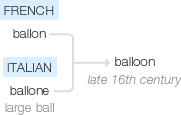Balloon
late 16th century (originally denoting a game played with a large inflated leather ball): from French ballon or Italian ballone ‘large ball’.
wiktionary
1570, "a game played with a large, inflated leather ball" (possibly via Middle French ballon) from Italian pallone(“large ball”) from palla(“ball”), from Lombardic *palla. The Northern Italian form, balla(“ball shaped bundle”), today a doublet, likely derived from Old French balle, from Frankish *balla(“ball”), and may have influenced the spelling of this word. Both Germanic words are from Proto-Germanic *ballô(“ball”), *balluz, from Proto-Indo-European *bʰoln-(“bubble”), from Proto-Indo-European *bʰel-(“to blow, swell, inflate”). Akin to Old High German ballo, bal(“ball”), (German Ballen(“bale”); Ball "ball"). Doublet of ballon. More at ball.
etymonline
balloon (n.)
1570s, "a game played with a large inflated leather ball tossed, batted, or kicked back and forth," also the ball itself (1590s), from Italian pallone "large ball," from palla "ball," from a Germanic source akin to Langobardic palla (from Proto-Germanic *ball-, from PIE root *bhel- (2) "to blow, swell") + -one, suffix indicating great size. Perhaps also borrowed in part from French ballon (16c.), altered (after balle) from Italian pallone. Also see -oon.
Meaning "bag or hollow vessel filled with heated air or (later) hydrogen or helium so as to rise and float in the atmosphere" is 1784, after the Montgolfier brothers' flights. As a toy air- or gas-filled inflatable bag, from 1858; as "outline containing words in a comic engraving" it dates from 1844. Balloon-frame (n.) "structure of light timber fitted together to form the skeleton of a building" is from 1853.
balloon (v.)
1792, "to go up in a balloon;" 1841, "to swell, puff up;" from balloon (n.). Related: Ballooned; ballooning.
